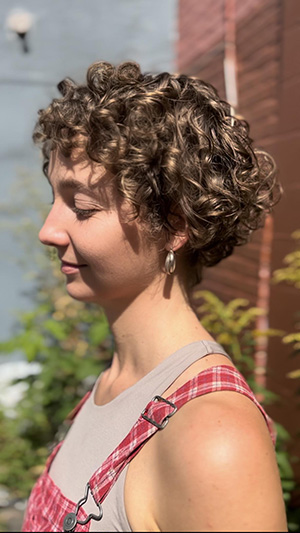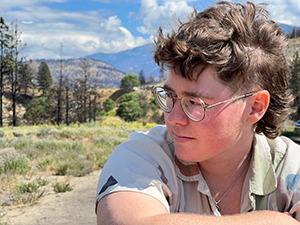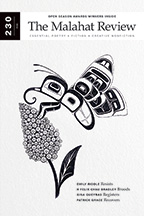Grief & Gratitude: Aldyn Chwelos interviews Alana Friend Lettner

Past contributor Aldyn Chwelos talks with Alana Friend Lettner, whose creative nonfiction piece “Little Beauty” appears in our spring issue #230. They discuss the sacredness of manual labour, sites of exploitation metamorphosing into sites that induce wonderment, and how to live is to be required to begin again and again and again.
Read an excerpt of “Little Beauty” here.
Alana Friend Lettner is a writer and poet whose work explores the convergence of ecology, embodiment, and the ethics of relation. Her essays have been shortlisted for The Malahat Review’s Constance Rooke Creative Nonfiction Prize, The Fiddlehead’s Creative Nonfiction Contest, and a Digital Publishing Award by the National Media Awards Foundation. She has been published in The Tyee; PRISM international; The Malahat Review; Fire Season III, an anthology of creative responses to the impacts of wildfire; and in “no monetary value,” a collaboration with interdisciplinary artist Chris Dufour about the ecologies of clearcuts, supported by Oxygen Art Centre. She also has essays forthcoming in Grist and carte blanche later this year. She holds a MFA in Writing from the University of Victoria.
This piece contains poignant and shifting perspectives on cutblocks and includes sections of writing from your past. I’m curious how these impressions from earlier tree planting seasons interacted with your contemporary ideas while you wrote.
The journal entries I make reference to in my essay are all from my later seasons of tree planting, once I’d overcome my personal psychic agony and started to develop an awareness of the broader ecological, political, and social context in which I was working. When this awareness first emerged in me, I felt a kind of blinding despair; all I could see was the devastation wrought by the forestry industry and my own complicity in it. I still see and feel this, but over time I have come to understand that such a perception also does violence to the land. Because even in its brokenness, the cutblock has been tremendously generous to me, even loving. I regard the cutblocks in which I’ve worked as some of my most important mentors. This double vision in which the grief and the gratitude coexist feels more honest to me. And in fact each has the same emotional root: love.
I was struck by the image of a future where “millions of pines grown to an identical age” could be looked upon like the Great Pyramids, “absolved of its violence by the incomprehensible fact of its emergence from manual labour.” Could you tell me how you arrived at that concept? How else do you see “terror being wonder’s understory” in our world?
My interest in imagining tree plantations thousands of years from now is not an attempt to absolve the forestry industry of its harms in the present, nor to justify its practices from the vantage point of some distant future, but rather to reflect on the ways in which the passage of time can impact perception. The Great Pyramids or the Great Wall of China are examples of how sites of exploitation—such as forced or conscripted labour—can metamorphose into sites that induce affects like wonderment. Tree planting is qualitatively different in that it is paid labour, and paid reasonably well. But perhaps it is not such a stretch to say that many of us find ourselves beholden to forms of labour we don’t always enjoy by the incessant demands of the prevailing economic mode.
In any case, what I am fundamentally interested in here is how the residual presence of hands, of human touch and human embodiment, is one of our most potent and enduring metrics of meaning. I think that the interest in architectural feats of the past actually speaks to an allegiance to physical presence, to the body: we care that we were there. Though often denigrated, manual labour is somewhat primordial and sacred for this reason. In these increasingly virtual times, it isn’t so difficult for me to consider how billions of trees planted by hand may come to seem incomprehensibly sublime.
This essay explores themes of ecological loss and ends by suggesting that “instead of the resonance of a chord, we may have to begin a new music with the lone vibrations of a single note.” This felt like wisdom that extends beyond the cutblock. Could you tell me more about this idea? What role might this “new music” play in imagining the future?
I actually have The Malahat Review editor Iain Higgins to thank for the emergence of this thought. The essay’s original ending focused on the whittling down of a chord to a single note with no mention of a possible new music. Iain observed that this had a somewhat bleak ring to it, and I agreed. On the scale of a single human life, one is often compelled to begin again after an encounter with loss: of a beloved person or animal; of one’s health; of one’s hopes for a particular future. To live is to be required to begin again and again and again. Of course, the loss of ancient, reliable, and familiar ecologies and climatological patterns is of a different order, maybe because it entails a confrontation with the possible loss of everything. Loss is perhaps the ultimate philosophical problem, writes Jan Zwicky in Lyric Philosophy, and I can think of no other philosopher who explores loss—especially ecological loss—with so much rigour, which is why Zwicky features centrally in my essay. The willingness to make a new music with what is left is not only existentially necessary but is, for me, an ethical obligation. It is an expression of responsibility to the world of which I am mercifully, irrevocably a part.
Gratitude to both Iain Higgins and Jan Zwicky for their contributions to my thinking.
You’ve also written a series of features in The Tyee about the work culture and politics of tree planting. I’m curious about the relationship between tree planting and writing? How do they shape each other?
I view both writing and tree planting as psychosomatic forms of piecework: planters get paid per tree, writers often get paid per word. And each is predicated on profound encounters with solitude. While the sense of community in bush camp is the most compelling reason that I’ve returned season after season, I often spend most of the working day alone in the land. The strength required to keep planting trees in the midst of hostile circumstances—thorns, bugs, hailstorms, punishing heat, punishing hills, injuries—is not so unlike the strength required to see a piece of writing through to its completion. To persevere in such solitary endeavours is not only a matter of discipline, but self-belief. Will and faith. In this sense, there is perhaps a relationship between one’s cultivation of strength and one’s capacity for surrender: while both writing and planting demand an extraordinary amount of effort, the true pleasure of each lies in the possibility of entrance into a flow state in which the labour feels effortless.
What’s a piece of creative or writing wisdom you carry with you or often return to? How has your relationship to that wisdom evolved over time?
If I could recommend one resource for any writer in any genre—though especially poetry—I would suggest listening to the two interviews with Jorie Graham on the literary podcast Between the Covers. I have returned to those recordings over and over again, and I always find something astonishing. Graham’s reflections on craft, process, and imagination have fundamentally altered my own relationship to writing; I trust other writers will find the piece of her thinking that most resonates with them.
What are you thinking of working on next?
I tend to toggle between genres, which often means that I have several projects on the go at any given time. Right now my focus is on drafting a book of poems in which each poem is voiced by a different organ of the body. It’s an incredibly playful and dynamic project that brings somatic explorations into contact with poetics. I am fortunate to be collaborating with two immensely gifted artists: filmmaker, writer, and visual artist Leander Kalil will provide illustrative renderings of each organ, and my brother Aaron Friend Lettner, a photographer and book maker, will do the book design and publish it under his imprint, Dædu.

Aldyn Chwelos









